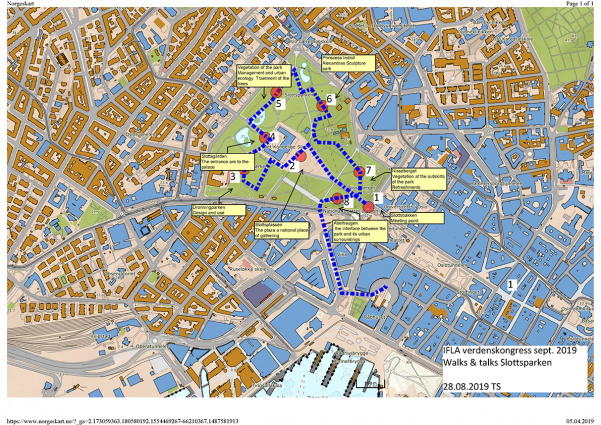Walks+Talks: Palace Park
Palace Park
The Palace Park is one of Oslo’s first public parks, displaying the romantic landscape style that dominated garden arts in the 1840s. Extensive perennial plantings, great lawns as well as some of the oldest trees in central Oslo characterize the park. Despite its historical roots, new ideas and styles are also implemented in the park design. One area is dedicated to native meadows, important for bees and pollinators. The park also contains seven historic statues as well as a newly opened section with sculptures designed in collaboration with children. The walk will introduce to the participants the history of the park and how it is the main outdoor area for national ceremonies. Information will be given about the use of the park as a public park in the city centre. We will talk about the maintenance program for vegetation with focus on the treatment of trees.
Slottsbakken
General about the walk and the park information.
Slottsparken is point of gathering in the national context. And an important green area in the centre of Oslo. History, use of the park in national context and as the city centre green area.
Slottsplassen
The structure of the Plaza, geometry and form. Speaker: Landscape architect Thor Johansen, The Royal court Description: Plaza of events in a national context. It is newly reconstructed.
Dronningparken (The Queens Park)
Dronningparken design and use Head Gardener Royal Estates Ane Senstad Guldahl, The Royal Court The first gardens were established in 1700. Historical information and gardens function today. Principals for vegetation management. Choice of vegetation considering sustainability.
Slottsgården (The Courtyard)
Use and design of the entrance area of the castle Speaker: Landscape architect Thor Johansen, The Royal court Description: Design and use of the courtyard
The vegetation of the park
Vegetation management Head Gardener Royal Estates Ane Senstad Guldahl, The Royal Court Landscape architect Thor Johansen, The Royal court Information about pollinators and bees, urban ecology, Maintenance of the trees in the park while walking through the western and northern parts of the park.
Princess Ingrid Alexandra’s Sculpture Park
The sculpture park Head Gardener Royal Estates Ane Senstad Guldahl, The Royal Court Landscape architect Thor Johansen, The Royal court The park was opened in 19th May 2016. Information about background, contents and choice of sculptures.
Nisseberget
Landscape architect Thor Johansen, The Royal court Nisseberget, facing the city centre, has a significant use of vegetation. It is a hedged area offering a calm and quiet contrast to the urban intensity of the city center. Refreshments will be served before the walk continue to Abelhaugen.
Abelhaugen
Interface between city and park
Landscape architect Thor Johansen, The Royal court
Abelhaugen was and still is an important element in the park, creating a visual and practical connection between the city and the castle. This part of the park is named after Niels Henrik Abel, a famous Norwegian mathematician. It is redesigned to a small but complex garden with a beautiful planting of roses and perennials.
IFLA World Congress 2019 will take a closer look at urban transformation, green mobility, healthy and beautiful landscapes and community participation. During three days in Oslo, we aim to inspire, challenge and intrigue you. We want you to share and reflect on the knowledge that is developed, presented and discussed.
Join us in moving one step further to understand and protect our COMMON GROUND.
This article is part of IFLA Common Grounds: Walk+Talk.
You can view all Walks+Talks tours here


